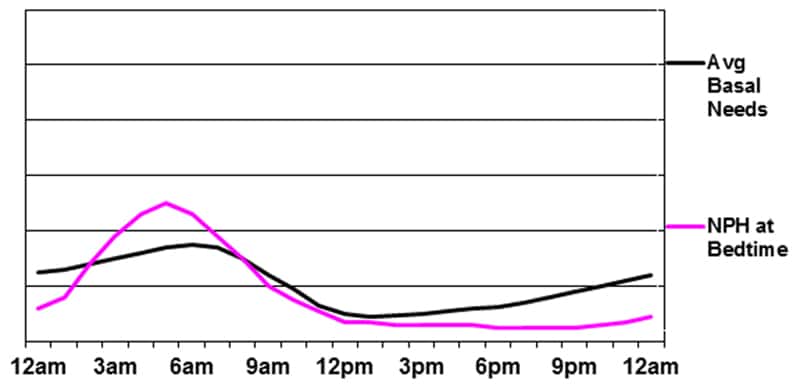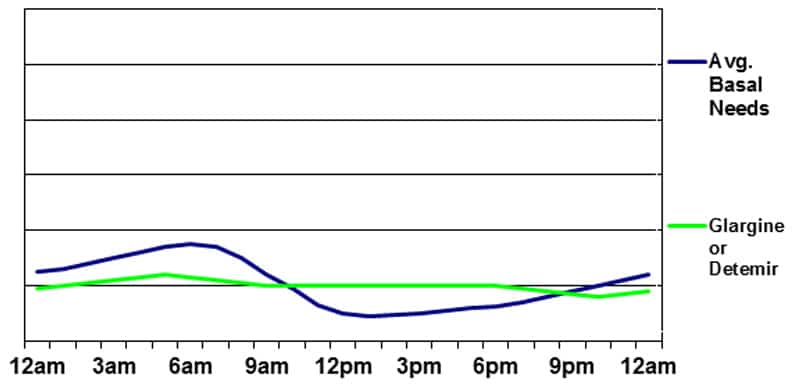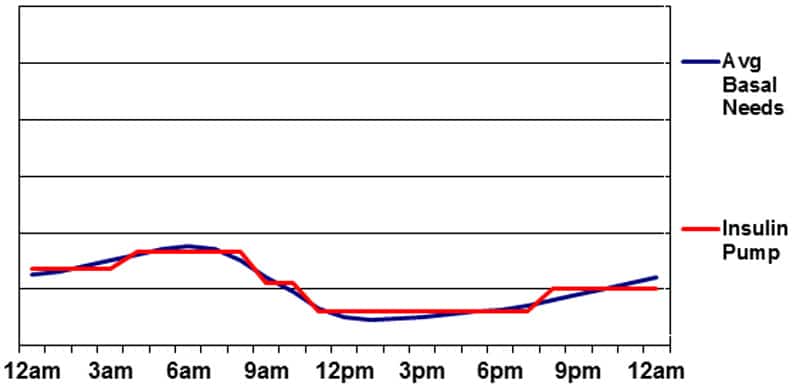(Managing Daybreak Phenomenon with Basal Insulin is excerpted from Assume Like A Pancreas: A Sensible Information to Managing Diabetes With Insulin by Gary Scheiner MS, CDE, DaCapo Press, 2011)

The liver is a captivating organ. It does a few hundred various things. Considered one of its most important capabilities is to retailer glucose (in a dense, compact kind referred to as “glycogen”) and secrete it steadily into the bloodstream as a way to present our physique’s very important organs and tissues with a continuing supply of gasoline. That is what retains your coronary heart beating, mind pondering, lungs respiratory and digestive system, uh, digesting, just about on a regular basis.
To be able to switch the liver’s regular provide of glucose into the physique’s cells, the pancreas usually secretes a small quantity of insulin into the bloodstream each couple of minutes. That is referred to as basal insulin. Not solely does basal insulin guarantee a gentle power supply for the physique’s cells, it additionally retains the liver from dumping out an excessive amount of glucose all at one. Too little basal insulin, or a whole lack of insulin, would lead to a pointy rise in blood sugar ranges.
So, you would possibly say that basal insulin and the liver are in “equilibrium” with one another. The basal insulin ought to match the liver’s secretion of glucose all through the day and night time. Within the absence of meals, train and rapid-acting/mealtime insulin, the basal insulin ought to maintain the blood sugar stage good & regular.
Every individual’s basal insulin requirement is exclusive. Usually, basal insulin wants are highest throughout the night time and early morning, and lowest in the midst of the day. That is because of the manufacturing of blood sugar–elevating hormones throughout the night time, and enhanced sensitivity to insulin that comes with daytime bodily exercise. Two hormones specifically – cortisol and progress hormone – trigger the liver’s pure ebb and circulate in glucose secretion.
Throughout an individual’s progress years (previous to age 21), basal insulin wants are usually comparatively excessive all through the night time, drop by way of the morning hours, and steadily enhance from midday to midnight. Most adults (age 21+) exhibit an abrupt enhance in basal insulin necessities throughout the early morning hours, adopted by a drop-off till noontime, a low/flat stage within the afternoon, and a gradual enhance within the night. This peak in basal insulin throughout the early morning hours is usually known as a daybreak phenomenon.
Basal insulin might be provided in quite a lot of methods. Intermediate-acting insulin (NPH) taken as soon as day by day will normally present background insulin across the clock, albeit at a lot larger ranges 4 to eight hours after injection and at a lot decrease ranges at 16 to 24 hours. Lengthy-acting basal insulins (glargine and detemir) supply comparatively peakless insulin ranges for roughly 24 hours. Insulin pumps ship rapid-acting insulin in small pulses all through the day and night time. With a pump, the basal insulin stage might be adjusted and fine-tuned to match the physique’s ebb and circulate in basal insulin wants. Additionally it is attainable to mix varied types of long-acting insulin to simulate the physique’s regular basal insulin secretion.
The next figures illustrate the motion profiles of varied sorts of basal insulin packages.
Basal insulin provided by NPH at bedtime
 The principle benefit of this program is the height that happens throughout the pre-dawn hours. The disadvantages embody the unpredictability of the height (because of NPH’s assorted fee of absorption from day after day), the potential for low glucose within the early morning (because of the important peak throughout the night time) and the probability that that late afternoon/night blood sugar will rise because the NPH tapers off.
The principle benefit of this program is the height that happens throughout the pre-dawn hours. The disadvantages embody the unpredictability of the height (because of NPH’s assorted fee of absorption from day after day), the potential for low glucose within the early morning (because of the important peak throughout the night time) and the probability that that late afternoon/night blood sugar will rise because the NPH tapers off.
Basal insulin provided by NPH within the morning and night

The benefits of this program are the height in basal insulin throughout the night time and the potential of utilizing the morning NPH peak to cowl the carbs eaten at lunchtime. The drawbacks are the identical as these in Determine 3 above, plus the most important concern of getting to adapt to a inflexible meal/snack schedule throughout the day because of the peak of the morning NPH insulin. Because the graphic clearly reveals, one of these basal insulin program does a poor job of matching the physique’s wants. It hardly ever produces steady glucose ranges – significantly throughout the daytime.
Sadly, those that use “premixed” insulin twice day by day are, primarily, using this strategy for his or her basal program. Every injection of premixed insulin comprises wherever from 50-75% NPH insulin, with the rest being both Common or rapid-acting insulin.
Basal insulin provided by glargine (Lantus) or detemir (Levemir)
 Glargine (Lantus) is normally taken as soon as day by day, however typically is taken twice – significantly when low doses are getting used. Detemir (Levemir) is normally taken twice day by day, however often might be taken as soon as a day. When basal insulin is injected twice day by day, it’s cheap to separate the doses evenly and take them roughly 12 hours aside. Taking extra within the night and fewer within the morning doesn’t normally produce a desired “peak” at any specific time. When taken as soon as day by day, it’s normally greatest to take the injection within the morning on a constant 24-hour cycle. Analysis has proven that the morning injection has the least potential to trigger an undesired blood sugar rise when the insulin is really fizzling out at round 20-24 hours.
Glargine (Lantus) is normally taken as soon as day by day, however typically is taken twice – significantly when low doses are getting used. Detemir (Levemir) is normally taken twice day by day, however often might be taken as soon as a day. When basal insulin is injected twice day by day, it’s cheap to separate the doses evenly and take them roughly 12 hours aside. Taking extra within the night and fewer within the morning doesn’t normally produce a desired “peak” at any specific time. When taken as soon as day by day, it’s normally greatest to take the injection within the morning on a constant 24-hour cycle. Analysis has proven that the morning injection has the least potential to trigger an undesired blood sugar rise when the insulin is really fizzling out at round 20-24 hours.
The principle benefit of utilizing glargine or detemir is the comparatively unwavering circulate of insulin (a really slight peak could happen 6 to 10 hours after injection of detemir) and constant absorption sample. The disadvantages embody the potential for a gradual blood sugar rise throughout the night time (because of the lack of a pre-dawn peak) and across the time of the injection when the insulin is taken as soon as day by day (the basal insulin could “put on off” a number of hours early and take a number of hours to “kick in”). There’s additionally potential for a gradual blood sugar drop within the afternoon because the basal insulin stage could exceed the liver’s manufacturing of glucose.
Basal insulin provided by Glargine or Detemir plus Night NPH
 To be able to overcome among the potential issues created by utilizing solely basal or NPH insulin to satisfy the physique’s basal wants, it’s attainable to mix the 2. When NPH is added at nighttime, glargine or detemir might be taken as soon as day by day at a decrease dose than if used with out NPH. This minimizes the chance of getting glucose ranges drop between meals throughout the day. By including a modest night or bedtime dose of NPH, a nighttime/early-morning peak might be achieved. This program affords the distinctive benefit of permitting day-to-day adjustment of the in a single day basal insulin stage by making minute modifications to the NPH dose with out affecting the basal insulin stage the next day.
To be able to overcome among the potential issues created by utilizing solely basal or NPH insulin to satisfy the physique’s basal wants, it’s attainable to mix the 2. When NPH is added at nighttime, glargine or detemir might be taken as soon as day by day at a decrease dose than if used with out NPH. This minimizes the chance of getting glucose ranges drop between meals throughout the day. By including a modest night or bedtime dose of NPH, a nighttime/early-morning peak might be achieved. This program affords the distinctive benefit of permitting day-to-day adjustment of the in a single day basal insulin stage by making minute modifications to the NPH dose with out affecting the basal insulin stage the next day.
The disadvantages embody the necessity for at the very least two separate injections and the filling of a number of prescriptions. There’s additionally potential for mixing up doses or taking the incorrect insulin on the incorrect time since a number of several types of insulin are being utilized concurrently.
Basal insulin provided by Insulin Pump Remedy
 Pump remedy affords the best diploma of maneuverability when it comes to matching basal insulin to the physique’s wants. As a result of small pulses of rapid-acting insulin are used to ship basal insulin, variations in peak or motion time are usually not a problem. Modifications might be made to the basal insulin supply on the hour or half-hour, so “peaks and valleys” can simply be constructed into this system. Pumps additionally allow non permanent modifications to basal insulin ranges as a way to accommodate short-term modifications in basal insulin wants (for conditions akin to sickness, excessive/low exercise ranges, and stress).
Pump remedy affords the best diploma of maneuverability when it comes to matching basal insulin to the physique’s wants. As a result of small pulses of rapid-acting insulin are used to ship basal insulin, variations in peak or motion time are usually not a problem. Modifications might be made to the basal insulin supply on the hour or half-hour, so “peaks and valleys” can simply be constructed into this system. Pumps additionally allow non permanent modifications to basal insulin ranges as a way to accommodate short-term modifications in basal insulin wants (for conditions akin to sickness, excessive/low exercise ranges, and stress).
Maybe the best downside to delivering basal insulin with a pump is the chance of ketoacidosis. Any mechanical downside leading to a scarcity of basal insulin supply can lead to a extreme insulin deficiency in just some hours. With none insulin within the bloodstream, the physique’s cells start burning massive quantities of fats (as an alternative of sugar) for power. The result’s the manufacturing of acidic ketone molecules—a pure waste product of fats metabolism. This hardly ever happens when taking injections of long-acting insulin since there’s nearly at all times some insulin working so long as injections are usually not missed.
Profitable pump use would require satisfactory follow-up and fine-tuning. This could embody:
- Basal fee testing all through the day and night time (fasting for 8- to 10-hour intervals and testing blood sugars to see if they’re holding regular)
- Superb-tuning of bolus formulation (primarily based on record-keeping)
- Troubleshooting and prevention of emergencies akin to DKA (diabetic ketoacidosis); and
- Use of superior pump options akin to prolonged boluses and non permanent basal charges.
Steered subsequent put up: My Experiments with Managing Daybreak Phenomenon
For those who favored this put up, please join our e-newsletter (and get a sign-up bonus) within the kind under. We ship out a weekly e-newsletter with the newest posts and recipes from Diabetes Robust.